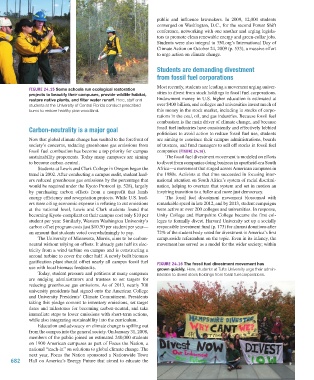Page 683 - Environment: The Science Behind the Stories
P. 683
public and influence lawmakers. In 2009, 12,000 students
converged on Washington, D.C., for the second Power Shift
conference, networking with one another and urging legisla-
tors to promote clean renewable energy and green-collar jobs.
Students were also integral in 350.org’s International Day of
Climate Action on October 24, 2009 (p. 533), a massive effort
to urge action on climate change.
Students are demanding divestment
from fossil fuel corporations
Most recently, students are leading a movement urging univer-
Figure 24.15 Some schools run ecological restoration
projects to beautify their campuses, provide wildlife habitat, sities to divest from stock holdings in fossil fuel corporations.
restore native plants, and filter water runoff. Here, staff and Endowment money in U.S. higher education is estimated at
students at the University of Central Florida conduct prescribed over $400 billion, and colleges and universities invest much of
burns to restore healthy pine woodland. this money in the stock market, including in stocks of corpo-
rations in the coal, oil, and gas industries. Because fossil fuel
combustion is the main driver of climate change, and because
Carbon-neutrality is a major goal fossil fuel industries have consistently and effectively lobbied
politicians to avoid action to reduce fossil fuel use, students
Now that global climate change has vaulted to the forefront of are aiming to convince their campus administrations, boards
society’s concerns, reducing greenhouse gas emissions from of trustees, and fund managers to sell off stocks in fossil fuel
fossil fuel combustion has become a top priority for campus companies (Figure 24.16).
sustainability proponents. Today many campuses are aiming The fossil fuel divestment movement is modeled on efforts
to become carbon-neutral. to divest from companies doing business in apartheid-era South
Students at Lewis and Clark College in Oregon began the Africa—a movement that surged across American campuses in
trend in 2002. After conducting a campus audit, student lead- the 1980s. Activists at that time succeeded in focusing inter-
ers reduced greenhouse gas emissions by the percentage that national attention on South Africa’s system of racial discrimi-
would be required under the Kyoto Protocol (p. 528), largely nation, helping to overturn that system and set in motion an
by purchasing carbon offsets from a nonprofit that funds inspiring transition to a fuller and more just democracy.
energy efficiency and revegetation projects. While U.S. lead- The fossil fuel divestment movement blossomed with
ers were citing economic expense in refusing to cut emissions remarkable speed in late 2012, and by 2013, student campaigns
at the national level, Lewis and Clark students found that were active at over 200 colleges and universities. In response,
becoming Kyoto-compliant on their campus cost only $10 per Unity College and Hampshire College became the first col-
student per year. Similarly, Western Washington University’s leges to formally divest. Harvard University set up a socially
carbon offset program costs just $10.50 per student per year— responsible investment fund (p. 173) for alumni donations after
an amount that students voted overwhelmingly to pay. 72% of the student body voted for divestment in America’s first
The University of Minnesota, Morris, aims to be carbon- campuswide referendum on the topic. Even in its infancy, the
neutral without relying on offsets. It already gets half its elec- movement has served as a model for the wider society; within
tricity from a wind turbine on campus and is constructing a
second turbine to cover the other half. A newly built biomass
gasification plant should offset nearly all campus fossil fuel Figure 24.16 The fossil fuel divestment movement has
use with local biomass feedstocks. grown quickly. Here, students at Tufts University urge their admin-
Today, student pressure and petitions at many campuses istration to divest stock holdings from fossil fuel corporations.
are nudging administrators and trustees to set targets for
reducing greenhouse gas emissions. As of 2013, nearly 700
university presidents had signed onto the American College
and University Presidents’ Climate Commitment. Presidents
taking this pledge commit to inventory emissions, set target
dates and milestones for becoming carbon-neutral, and take
immediate steps to lower emissions with short-term actions,
while also integrating sustainability into the curriculum.
Education and advocacy on climate change is spilling out
from the campus into the general society. On January 31, 2008,
members of the public joined an estimated 240,000 students
on 1900 American campuses as part of Focus the Nation, a
national “teach-in” on solutions to global climate change. The
next year, Focus the Nation sponsored a Nationwide Town
682 Hall on America’s Energy Future that aimed to educate the
M24_WITH7428_05_SE_C24.indd 682 13/12/14 10:40 AM

